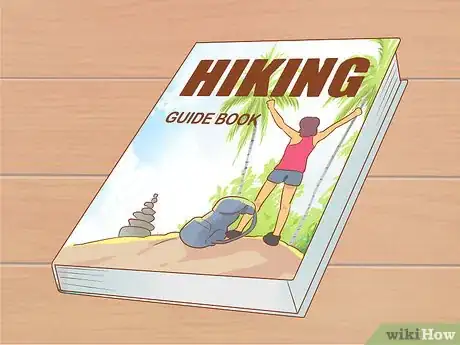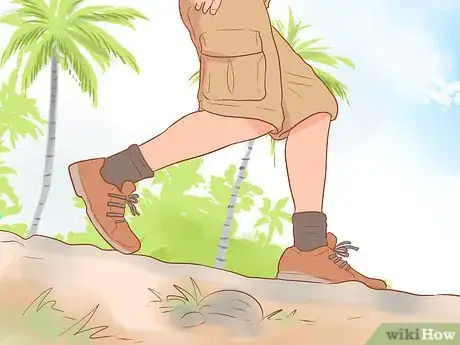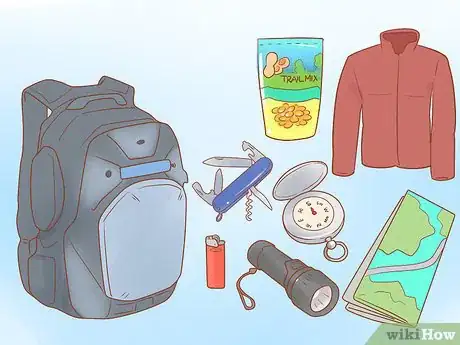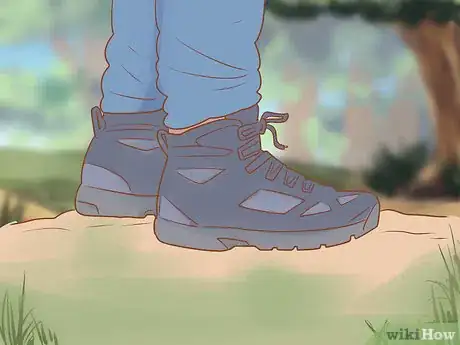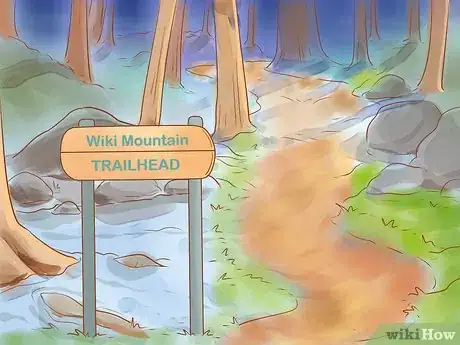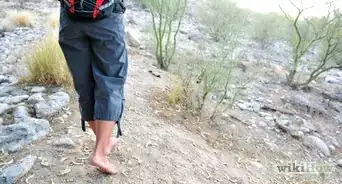This article was co-authored by Thomas Churchill. Thomas Churchill has been leading hiking and backpacking trips across California for the last five years as a Stanford Pre-Orientation Trip Leader and Adventure Program Guide. Most recently, Thomas was a Hiking Leader for 3 months at Stanford Sierra Conference Center, leading day hikes in the Desolation Wilderness of Northern California.
This article has been viewed 117,765 times.
There are very few things more pleasant than hiking through the great outdoors. The sun warming your shoulders, nature all around you, and an incredible view before you--trails can truly be paradise. However, hiking can also be dangerous if not done properly. It is incredibly important to prepare for a hiking trip, and to know what to do once you get out onto the trail.
Steps
Preparing for Your Hike
-
1Buy a local guidebook. Hiking guidebooks are essential when it comes to finding the right hike for you. Local guidebooks will also tell you all about the natural landscape around you--from wildflowers you will see while hiking during different seasons, to the types of birds you will see flying overhead. You should be able to purchase a local hiking guide at your local bookstore, outdoor adventure store, or at your regional park’s visitors center. You can also purchase them online.
- You can also search online for hikes in your area. Chances are, you will find a bunch of websites detailing some great hikes right near your house--even if you live in the heart of a city like San Francisco. (If you actually do live in SF, go check out the Marin Headlands!)
EXPERT TIPThomas Churchill has been leading hiking and backpacking trips across California for the last five years as a Stanford Pre-Orientation Trip Leader and Adventure Program Guide. Most recently, Thomas was a Hiking Leader for 3 months at Stanford Sierra Conference Center, leading day hikes in the Desolation Wilderness of Northern California.Hiking & Backpacking Trip Leader
 Thomas Churchill
Thomas Churchill
Hiking & Backpacking Trip LeaderWhile paper maps are important to carry as a safe measure, technology has gotten better for hiking. Thomas Churchill, Hiking and Backpacking Guide, says: “I recommend downloading the app Topomaps+— or something of the sort — from the app store before hiking a new route. The app lets you download detailed hiking maps of any trail and see your location on those maps offline.”
-
2Start small. If this is your first time hiking, you should choose a relatively easy hike. Look for short day hikes that are a manageable distance for your abilities. If you rarely ever go out into nature, you might want to stick with a flat one or two mile track. For others who exercise regularly, an easy five mile round trip hike may be more your style--it’s really up to you. Just don’t push yourself too hard your first time out.[1]Advertisement
-
3Bring lots of water. One of the most important things to know when learning how to hike safely is that you need to bring the right amount of water. Staying hydrated is really important, so drink a good amount of water before you head out on your hike. Bring more water than you think you will need--it’s better to carry extra water than not bring enough and become dehydrated. A good rule of thumb is to bring at least one liter of water per person for every two hours of hiking.[2] Bring even more if the hike is particularly hot or strenuous.
-
4Pack your backpack. Depending on the length of your hike, you may consider bringing different things. In general, however, you should always bring some sort of energy-boosting snack (you can never go wrong with trail mix), a knife of some kind (Swiss Army knives are great), a compass and map, a flashlight, matches or a lighter, and an extra layer of clothing (in case the weather changes suddenly) and snacks[3]
- You could also consider bringing a first aid kit, binoculars, etc. Just remember that you don’t want to weigh yourself down with unnecessary items. Always bring plenty of water, though.
- If you are going for a hike during the coronavirus pandemic, make sure to bring a face mask and wear it whenever you are near other people on the trail.
-
5Protect yourself from the sun. Along with the other items you have packed in your backpack, you will also need to bring supplies to protect you from the sun. This includes sunscreen, a hat, and sunglasses. Getting sun poisoning or skin cancer is no laughing matter, so do anything you can to protect yourself from the sun’s harsh rays.
-
6Wear the right shoes. It’s important to wear shoes that will make your trailblazing easier. Skip the flip-flops and go for lace-up shoes that give you good arch support. If you can, wear hiking boots or trail shoes--these will be the best for maneuvering in rough terrain. Combat boots are also great--these can be worn for a long time on rough terrain and still be comfortable. If it's tick season, tuck your pant legs into your socks--you don't want to get bitten and infection from ticks spread to you.
- If you have new shoes that you’ve never worn before, break them in before you set out on your hike. If you don’t, you could end up with some nasty blisters on your feet.
-
7Ask some friends or family to go with you. Beginning hikers should stick together or go with more experienced hikers before they head out on the trail by themselves. This is because it is much more difficult to get help if you are hiking solo and something happens to you. Plan a hike and ask your friends to come along for the fun of it, but also as a safety precaution.[4]
- If you do decide to hike solo, let someone else know where you are going and when you plan to be back. Tell them you will contact them after you are done with your hike. Do not forget to actually contact them or they may call emergency services.
-
8Know what to do in case of an emergency. While it is more than likely that your hike will go perfectly smoothly, you should always be prepared for the unexpected. Carry a first aid kit with you, and bring your cellphone. Be prepared, however, that you may not have reception out in the woods. For an extensive guide on how to survive in the wild, click here.[5]
On the Trail
-
1Begin at the trailhead. Each trail begins with a trailhead--a sign that generally states the name of the trail and the distance to the end (or how long the loop is.) Other trailhead, like those in national parks, will have a map of all of the other trails your trail connects to, as well as different things to look out for while hiking.
- If you cannot find a trailhead, you may not be at the right location. Ask someone for directions. Other trails might not have a trailhead--this fact will be specified in your trail guide.
-
2Look for trail markers. When you are out hiking, you will inevitably come across a fork in the road. Follow the trail markers that say your trail’s name. If there are no markers available (which is relatively rare) consult your map and look for cairns. Cairns are stacks of rocks that rangers make to show hikers the correct path to take.
- You may see small trails branching off from your trail. Do not follow these--often they are simply deer and other forest creature paths that will lead you into uncharted territory. Park rangers and trail maintenance people generally block off these sort of faux-trails by dragging fallen tree branches across the path.
-
3Obey all signs. If you see a sign that says “Stay on the trail” you should--you guessed it--stay on the trail. It is more than likely that that sign is there because there is revegetation happening in the area. When too many people walk in areas other than the path, they can do serious damage to the vegetation.
- You will also most likely see a sign that says do not feed wild animals. This is really good advice, as feeding wild animals can hurt both you and the animals. Do not feed wild animals--no matter how cute they look.
-
4Take breaks and rehydrate. Hiking is not a race, but rather an activity that you can do at your own speed. Don’t be afraid to slow down if you are feeling tired. Drink water throughout your hike and sit down for a rest whenever you feel the need to do so.
-
5Look out for critters that might be underfoot. Be aware that when you are hiking, you are passing through the home of many different creatures--from the smallest bugs, to the biggest bears. Do not ever try to approach or interact with wild animals because they are just that--wild.
- In particular, look out for snakes. Be careful when walking in rocky areas where snakes are known to reside--stepping on a snake is never a good thing.
-
6Take only pictures, leave only footprints. This is a saying we are taught when we are young but it remains true. The wilderness is a place of beauty that must be respected. Do not throw your trash on the ground, disturb the peace by blasting music or talking at the top of your lungs. Do not take rocks, plants or animals with you when you leave the trail--if you do, you are disrupting the beautiful ecosystems around you. To be a true hiker, you must respect nature.[6]
Expert Q&A
-
QuestionHow can I be safe on a hike?
 Andrea ThompsonAndrea Thompson has been living in New Zealand for over five years, after moving there from England. She enjoys spending time outdoors in New Zealand and exploring the South Island's coast, bush and mountains alike.
Andrea ThompsonAndrea Thompson has been living in New Zealand for over five years, after moving there from England. She enjoys spending time outdoors in New Zealand and exploring the South Island's coast, bush and mountains alike.
New Zealand Resident If you're going hiking, tell someone where you're going. If you're half way up a mountain, or down a cave and you can't dial 111, you need to have told someone where you were going before hand so they know to look send out rescue services when you don't come back when expected. The emergency support system for finding lost hikers is good — LandSAR and Civil Defence will make every effort to rescue you.
If you're going hiking, tell someone where you're going. If you're half way up a mountain, or down a cave and you can't dial 111, you need to have told someone where you were going before hand so they know to look send out rescue services when you don't come back when expected. The emergency support system for finding lost hikers is good — LandSAR and Civil Defence will make every effort to rescue you. -
QuestionHow can you hike up a mountain without falling down
 Community AnswerWatch the terrain, and don't hike straight up, but rather zigzag it if the path is steep. Wear proper hiking boots.
Community AnswerWatch the terrain, and don't hike straight up, but rather zigzag it if the path is steep. Wear proper hiking boots. -
QuestionWill a map and compass work?
 Community AnswerAs long as the map includes the route you are taking, it should.
Community AnswerAs long as the map includes the route you are taking, it should.
Warnings
- Follow all trail markers and signs. Stay on the trail or you run the risk of becoming lost.⧼thumbs_response⧽
References
- ↑ http://hikesafe.com/index.php?page=things-to-consider
- ↑ http://tetonsports.com/adventureblog/how-much-water-should-you-carry-for-your-hike/
- ↑ http://www.rei.com/learn/expert-advice/day-hiking-checklist.html
- ↑ http://www.nerdfitness.com/blog/2011/09/07/hiking/
- ↑ http://hikesafe.com/index.php?page=what-to-do-if-lost
- ↑ http://www.llbean.com/outdoorsOnline/outdoorSports/hiking/tips/lowimpact.html
About This Article
Before you hike, break in a pair of hiking boots or trail shoes, and pack a backpack with essentials, like food and water, extra layers of clothes, and a first aid kit. Then, invite some friends or family to go with you since there’s safety in numbers, and start at a trailhead, where you’ll find a sign with the hike’s name, length, and special features. Once you head out, look for trail markers, and make sure to follow only the ones for your trail. Additionally, make your way at a comfortable speed, taking plenty of breaks to rest and rehydrate. For tips on how to figure out how much water to take on your hike, scroll down!
